Hubert John Gray, 1882 – 1963
by Brian Stevenson
last updated July, 2017
Microscope slides by H.J. Gray are relatively common, covering a wide variety of subjects, and ranging in quality from exceptional to mediocre (Figures 1, 2, and 7). He evidently developed into a skillful mounter of arranged diatoms, and collectors would do well to keep an eye out for such mounts (Figures 2 and 7).
Gray began selling microscope slides in about 1918, which would have been around the time he was discharged from the army. Advertisements from the beginnings of his business indicate that he had large numbers of slides for sale at discount prices. For example, he published this in 1919, “68 first-class physiology slides. Original price £2 12s.; accept 26s. Also 24 various subjects 8s. - Gray. 31, Grange Road, Lewes, Sussex”. Similar advertisements appeared during 1921 (Figure 3). Noting that a number of slides labeled by Gray were actually made by J.B. Howard or A.P. Drake (who had acquired Howard’s stock of slides in 1917 and sold them under his own name), and that Drake appears to have ceased selling slides in 1919, it is probable that Gray got his start as a microscope slide dealer by acquiring Drake’s inventory (Figures 4 and 5). By mid-1921, Gray appears to have been making his own slides, including preparations of radioactive radium (Figures 3 and 6).
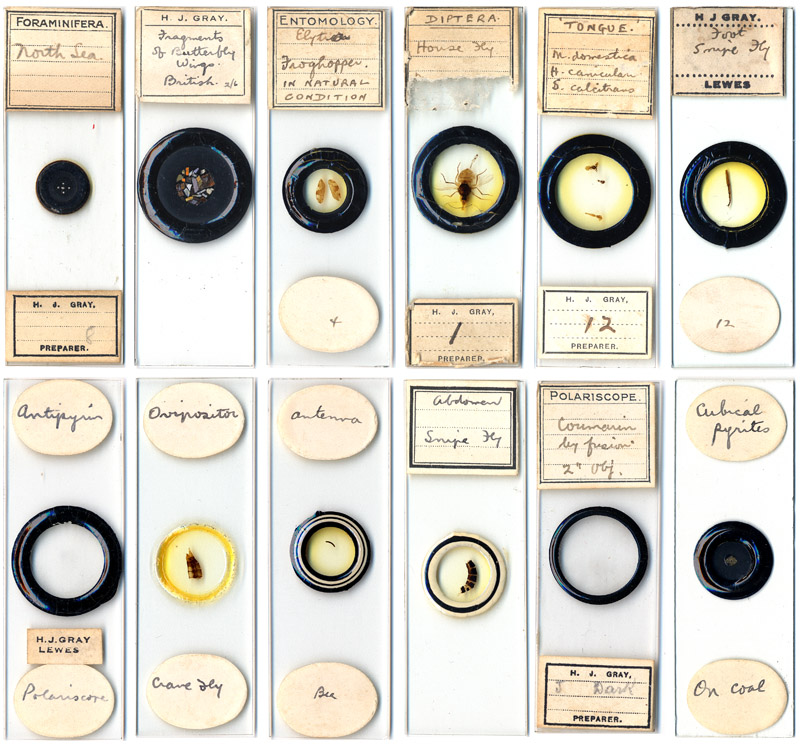
Figure 1.
Examples of microscope slides labeled by Hubert John Gray. His messy handwriting is quite distinctive. Additional examples of Gray’s slides may be seen in ‘Microscopical Mounts and Mounters’, plates 20 and 53. Gray published hints for mounting insects and chemicals, so such slides are likely to have been made by him. Figures 4 and 5 show slides with Gray’s name labels, but evidently made by other people. The handwriting and mounting style are probably the keys to identifying whether or not Gray made a particular slide.
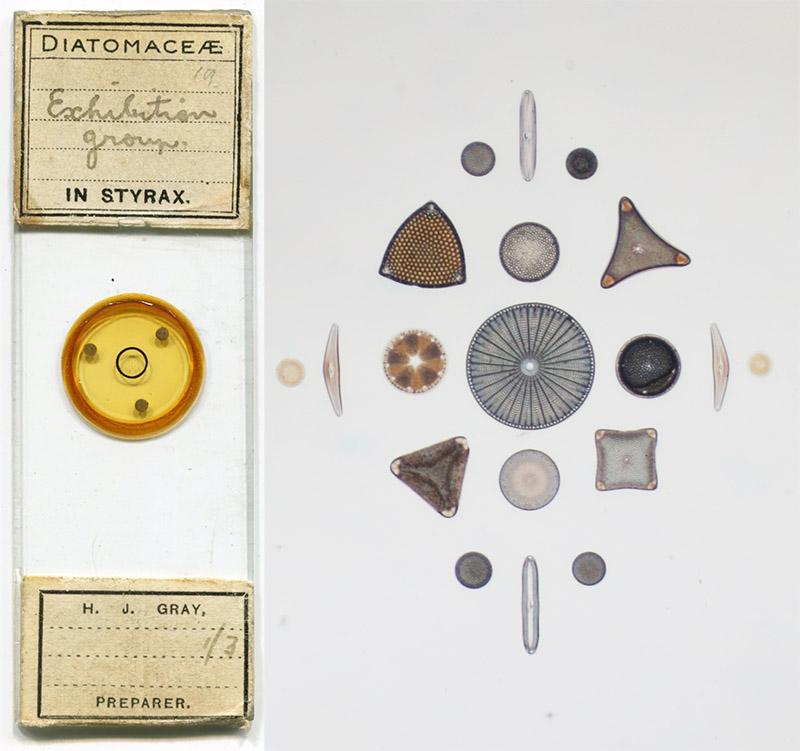
Figure 2.
A slide of arranged diatoms.

Figure 3.
Advertisements from H.J. Gray, published between January and July, 1921. He moved from 39 to 40 Grange during the spring of that year. An example of Gray’s radium slides is shown in Figure 6.
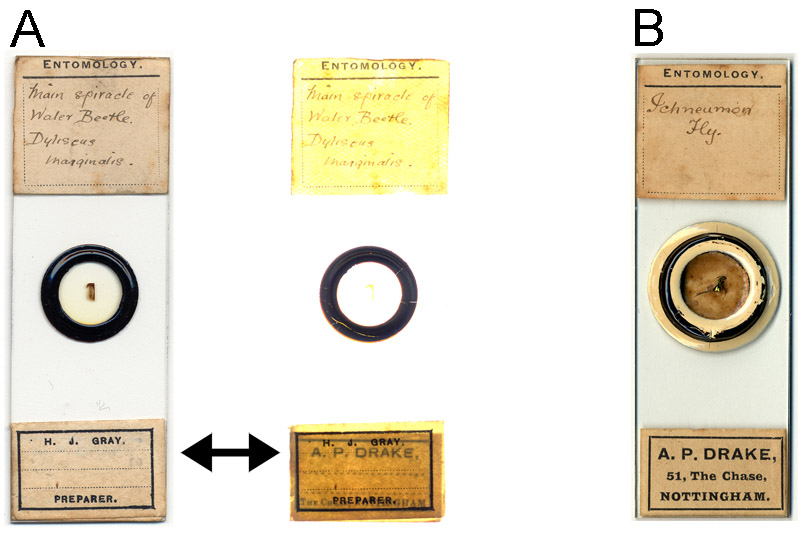
Figure 4.
(A) A microscope slide of a water beetle’s spiracle labeled “H.J. Gray – Preparer”. The handwriting on the descriptive label is very different from Gray’s (compare with Figures 1 and 2). Another label is present under Gray’s name plate: enhanced contrast transmission scanning revealed that it is the label of Arthur P. Drake. Drake appears to have ceased selling slides at about the same time as Gray began. This and other Drake-produced slides suggests that Gray may have acquired Drake’s slide stock.
(B) An example of a slide labeled by Drake. The handwriting is similar to that on the slide shown in panel A. Another Drake slide is shown in Bracegirdle’s ‘Microscopical Mounts and Mounters’, plate 12-R (ironically, the other Drake-labeled slide shown in ‘Microscopical Mounts and Mounters’ as plate 12-S, was actually made by James B. Howard)
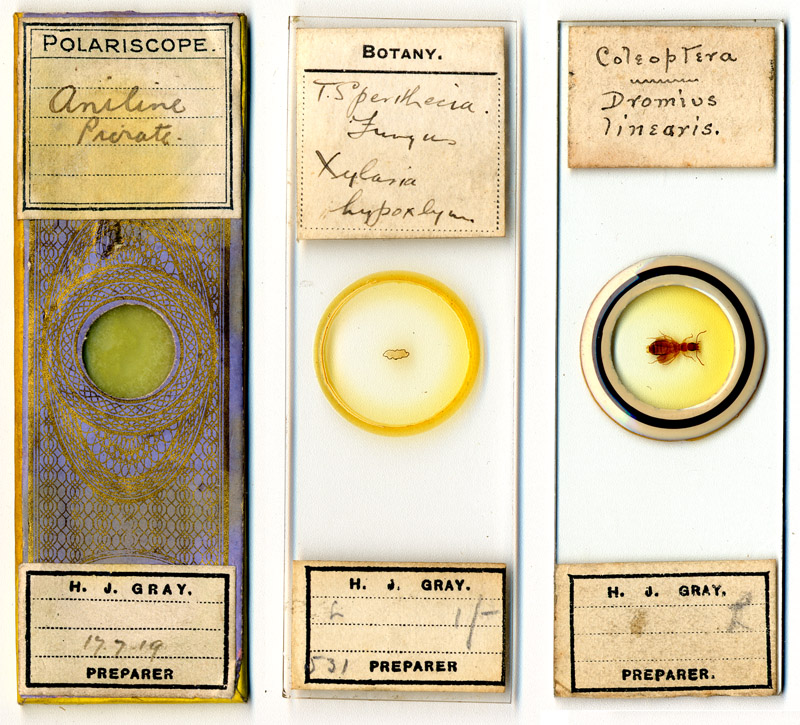
Figure 5.
Three additional microscope slides that almost certainly were not produced by Hubert Gray. Left, a slide wrapped in papers that were common circa 1870, before Gray was born. Center, the specimen label appears to bears James B. Howard’s handwriting. Right, the handwriting resembles that of Arthur P. Drake. Some re-labeling may have been Gray passing along slides he acquired but
did not want to keep. Noting that Drake bought up Howard’s stock of slides in
1917, and subsequently re-labeled them with his own name, it is possible that
Drake sold these slides to Gray with full knowledge that Gray would re-sell
them.
Hubert
John Gray was born November, 1882, in Deptford, Kent (London),
In 1911, Hubert Gray was living alone at 11 South Moulton Street, London. He reported on that year’s census that he worked as a “ledger clerk”.
Gray’s earliest known scientific foray was a February 21, 1914 paper on botany during Elizabethan times. The following year, he published numerous articles on a variety of topics. He wrote two articles for Modern Mechanics, on “finding the focus of a lens” (regarding
photographic lenses) and how “to purify mercury”.
American Photography published his “handy distilled water bottle”, how to prepare “a useful measuring tube” (on
how to build a pipet), “to correct a faulty thermometer”, “storing photographic chemicals”, and how to ascertain “the life of the fixing bath”. Gray’s article on “an exciter for electrostatic experiments”, and a brief note on “how to make wire
bolts for wooden boxes”,were published in The Popular Science Monthly.
Gray also contributed an article on “magic pictures” to the 1917 British Boy’s Annual, while he was serving in the military.
At the age of 33, Hubert Gray was drafted into the Army on March 1, 1916, then
mobilized on September 19, 1916. At that time, his address was 40 Grange Road,
Lewes, Suffolk, and he had been employed as a “commercial clerk”. Later military records refer to Gray’s occupation
as having been a “reporter”, possibly
referring to his above-mentioned publications. The 33 year-old Gray was
initially inducted into the 6th (Cyclist) Battalion, Suffolk
Regiment, and then into the 14th Suffolk Regiment on October 13,
1917. He served in England throughout his duty. Gray’s pension records
described him as being 5 feet, 5 inches tall, weighing 116 pounds, having a
35 inch chest, wearing glasses and having “defective
teeth”. On March 20, 1918, Military Police found Gray “wandering aimlessly about”. At a medical evaluation, Gray reported
that he “had a lot of domestic things to
worry him”, and that “a month ago”
he “lost himself”. The examining
officer wrote that Gray was “trembling
and confused and incoherent . . does not realize his position”. Gray also stated that he had a “nervous breakdown” in 1913. He was diagnosed with “mania” and discharged on May 31, 1918 as
“being no longer physically fit for war service”.
By 1919, Gray was in business as a microscopist. In addition, that year’s Boy Mechanic: 800 Things for Boys to Do included two photography
articles written by Gray, “Loading Box to Dispense with Dark Room” (a lightproof glove box that allowed manipulation of film) and “Test Exposures for Bromide”.
Henry J. Gray married Maryon Isabel Saxby during the summer of 1921, in Lewes. He would then have been 38 years old.
Also in 1921, Gray advertised, “Microscopical Slides - Real Radium,
perpetually scintillating. Wonderful and fascinating, 2s. 9d. General subjects few pence. List free. Mention The
Chemical Age.- Gray, 40, Grange Road, Lewes.” (see also Figure 3). An example of one Gray’s
radioactive slides is shown in Figure 6. The Museum of the History of Science,
in Oxford, England, holds a “Drawing Room
Radium Outfit”, made by "H. J.
Gray, 40 Grange Road, Lewes, Sussex", and “dated 1 February 1923”. The Museum describes the outfit thusly: “The box contains seven microscope slides
with small samples of barium platinocyanide, willemite, carnolite, blende, gas
mantle, pitchblende, and 'radium spot'; also a small lens, sealing wax,
gold-leaf, paper, Dutch metal (or lead foil) and aluminium screens for
absorbing the alpha and beta radiation, and a 'self luminous radium screen'
(zinc sulphide). The aluminium screens were added more recently for observing
beta particle energies. These kits were quite popular during the first decades
of the 20th century. With them could be demonstrated the 'fogging' of
photographic plates and the ionisation of the air by the radiation (the latter
shown by the collapse of the leaves of a charged gold-leaf electroscope), and
the most spectacular of all - the 'scintillations' of the alpha particles
produced when the zinc sulphide screen was placed on top of the 'radium spot',
viewed in the dark with the small lens provided. The maker of this kit warns
his amateur experimenter not to have his eyes too close to the radium or to
view it for very long! Finally, he must NOT finger the radium salt which is
very poisonous.”
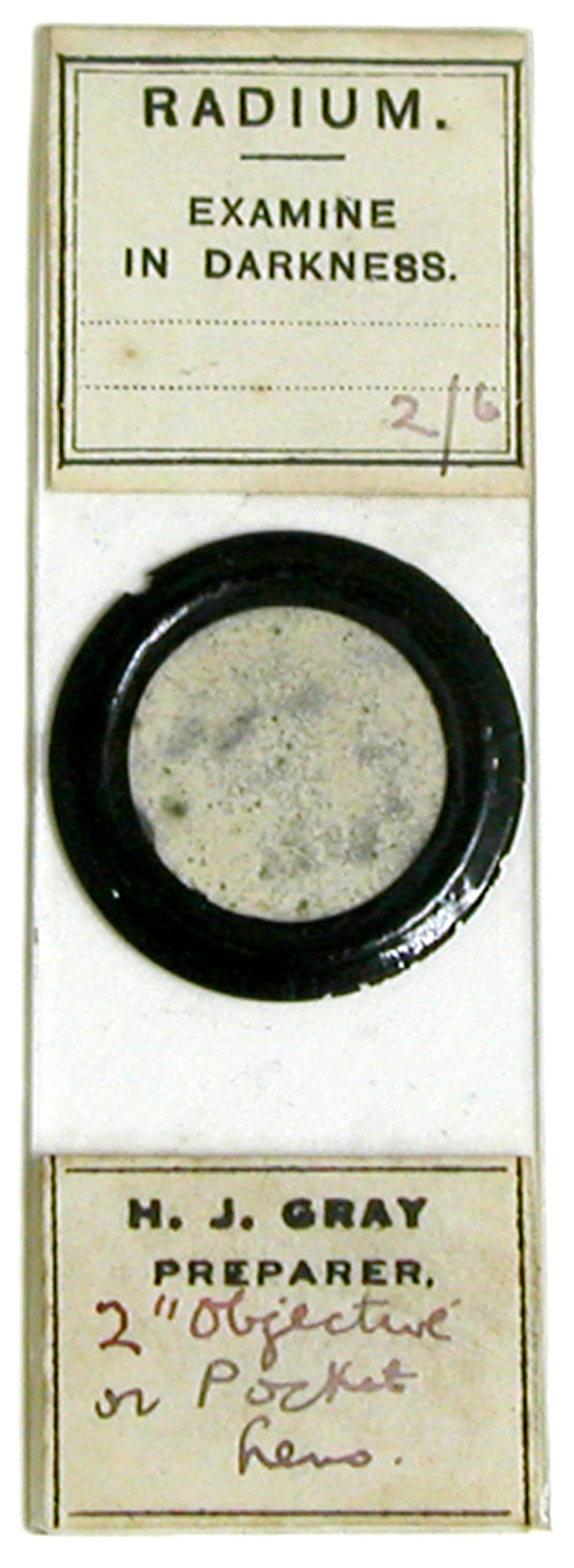
Figure 6.
A microscope slide of radium, by Hubert J, Gray, circa 1921. Image from the Oak Ridge Associated Universities Health Physics Historical Instrumentation Collection.
Gray shared some slide-making tips with readers of Watson’s Microscope Record, with “A method of mounting crystals for the
micro-polariscope” in 1927, and “Memoranda
from a mounter” the following year.
Presumably, Gray continued making and selling microscope slides and supplies for many more years, although we have not yet found record of his activities. If any readers are aware of Gray’s whereabouts or occupation after 1928, I will be pleased to update this essay and give appropriate credit.
Hubert’s wife, Maryon, died on March 1, 1939. The slide
maker was probably the Hubert J. Gary who died in the Chichester area during
late 1963.
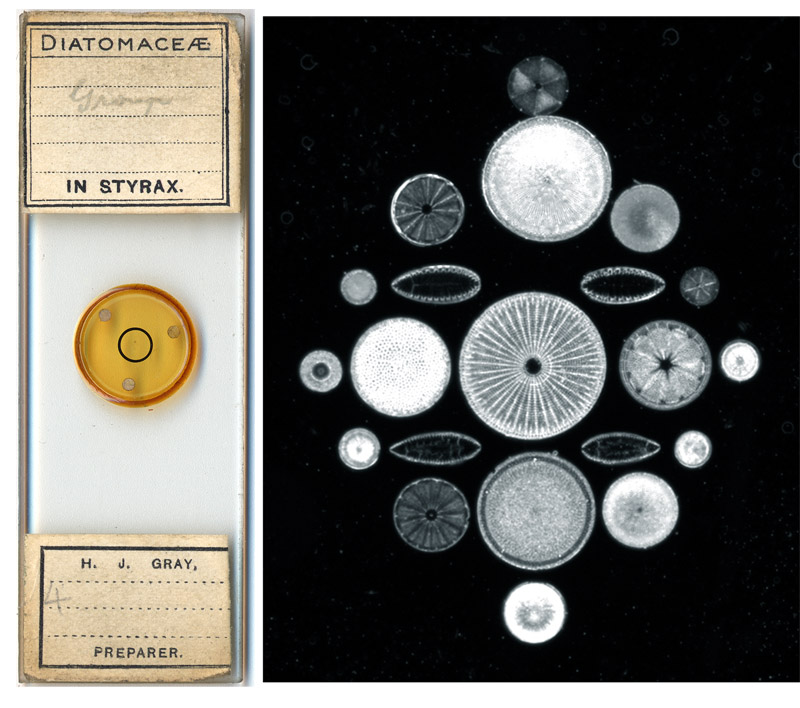
Figure 7.
An exceptional slide of arranged diatoms.
Acknowledgement
My thanks to Steven Gill for his superb historical investigations and for freely sharing the results of his research.
Resources
Bracegirdle, Brian (1998) Microscopical Mounts and Mounters, Quekett Microscopical Club, London.
Pages 32, 47 and 54, and plates/slides 12-R, 12-S, 20-A, 20-B, 20-C, 20-D,
21-K, 21-L, 21-M, 53-M
British Medical Journal (1914)
Literary notes (on Elizabethan botany, by H.J. Gray), Feb. 21
The Chemical Age (1921) Advertisements from H.J. Gray, Vol. 5
England census, birth, marriage and death records, accessed
through ancestry.co.uk
The English Mechanic and World of Science (1919) Advertisement from H.J. Gray, page 120
Gray, H.J. (1915) Finding the focus of a lens, Modern Mechanics, Vol. 3, p. 375
Gray, H. John (1915) To purify mercury, , Modern Mechanics, Vol. 3, pp. 799-800
Gray, H. John (1915) A useful measuring tube, American Photography, Vol. 9, p. 438
Gray, H. John (1915) To correct a faulty thermometer, American Photography, Vol. 9, p. 438
Gray, H. John (1915) Storing photographic chemicals, American Photography, Vol. 9, p. 438
Gray, H. John (1915) The life of the fixing bath, American Photography, Vol. 9, p. 438
Gray, H. John (1915) A useful measuring tube, American Photography, Vol. 9, p. 438
Gray, H. John (1915) An exciter for electrostatic
experiments, Popular Science Monthly,
Vol. 87, pp. 513-514
Gray, H.J. (1915) Wire bolts for wooden boxes, Popular Science Monthly, Vol. 87, p. 673
Gray, H.J. (1916) Handy distilled water bottle, American Photography, Vol. 10, p. 210
Gray, H. John (1917) Magic pictures, The British Boy’s Annual, Cassell, London
Gray, H.J. (1919) Loading box to dispense with dark room, The Boy
Mechanic: 800 Things for Boys to Do, Vol. 3, Popular Mechanics Press,
Chicago, p. 268
Gray, H.J. (1919) Test exposure for bromide enlargements, The Boy
Mechanic: 800 Things for Boys to Do, Vol. 3, Popular Mechanics Press,
Chicago, p. 411
Gray, H. John (1927) A method of mounting crystals for the
micro-polariscope, Watson’s Microscope
Record, No. 11, p. 17
Gray, H. John (1928) Memoranda from a mounter: ‘Mounting
insect parts in natural condition’, Cedar oil balsam’, and ‘A background for opaque slides’, Watson’s Microscope Record, No. 15, pp. 26-27
Journal of Microscopy (1921) Advertisement from H.J. Gray, Vol. 41
Museum of the History of Science web site (accessed August,
2012) Inventory no. 28569, “Drawing room radiumre. Robert’s occupation was listed as “Optician, Landowner, Employing 15 men, 6 boys, 2 women, 5 girls”, indica outfit”, https://www.mhs.ox.ac.uk/collections/search/display-narrative/?irn=7166&index=2
Oak Ridge Associated Universities Health Physics Historical Instrumentation Collection (accessed August 2012) “H. J. Gray Spinthariscope”, http://www.orau.org/ptp/collection/spinthariscopes/Slide.htm
The Pharmaceutical Journal and Pharmacist (1921) Advertisements from H.J. Gray, Vol. 106
�
World War I pension record of Hubert John Gray, accessed
through ancestry.co.uk






